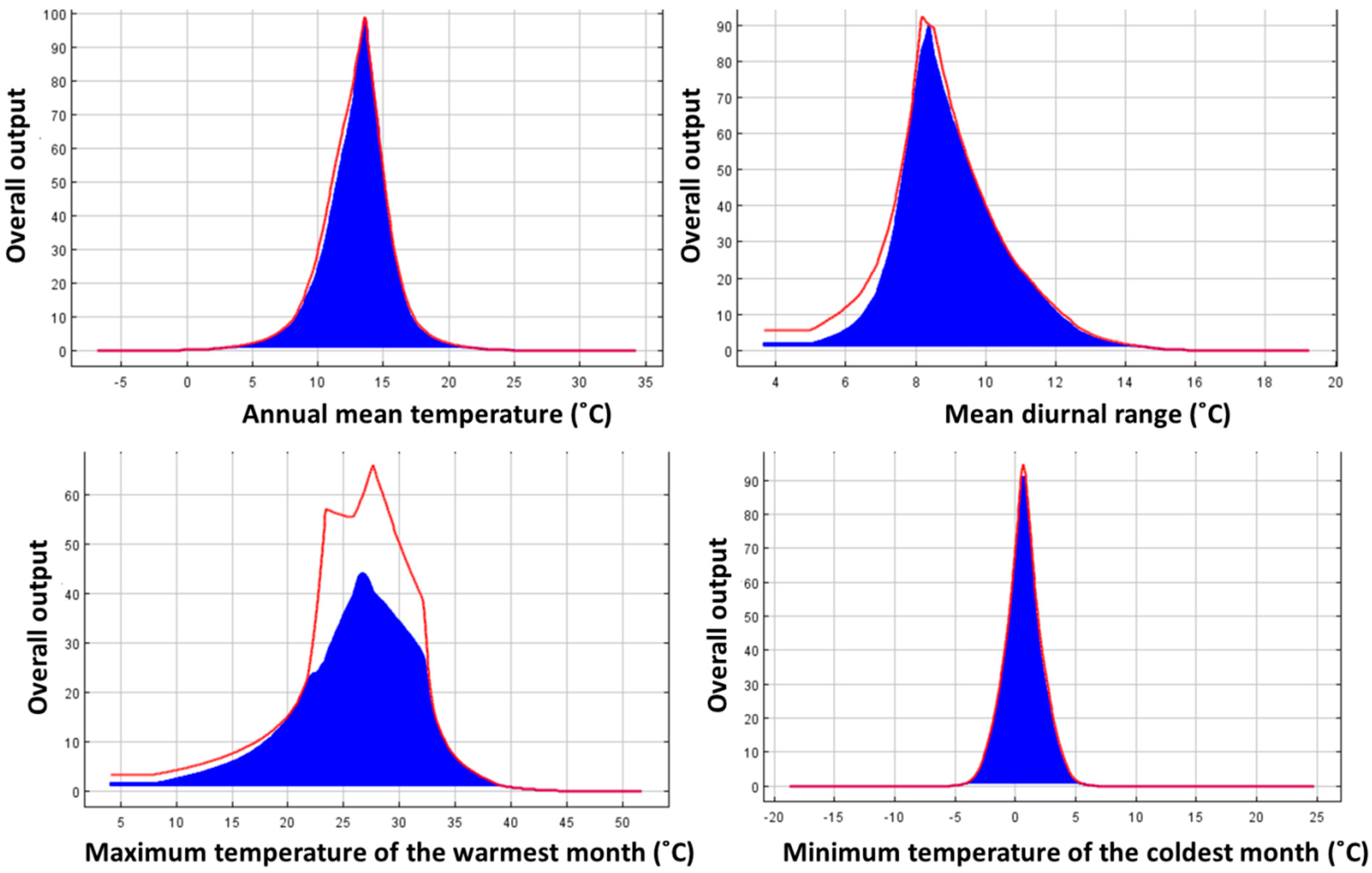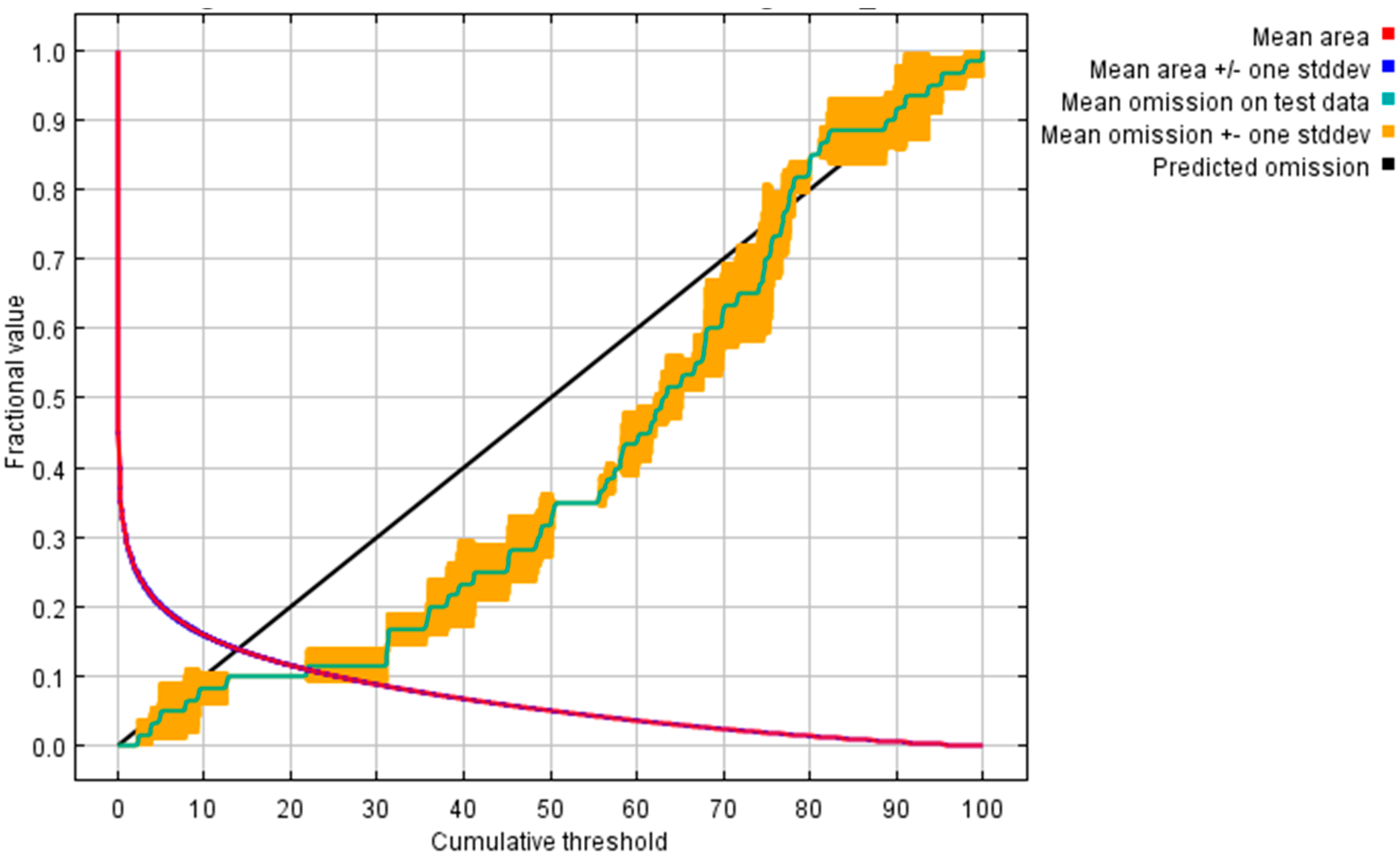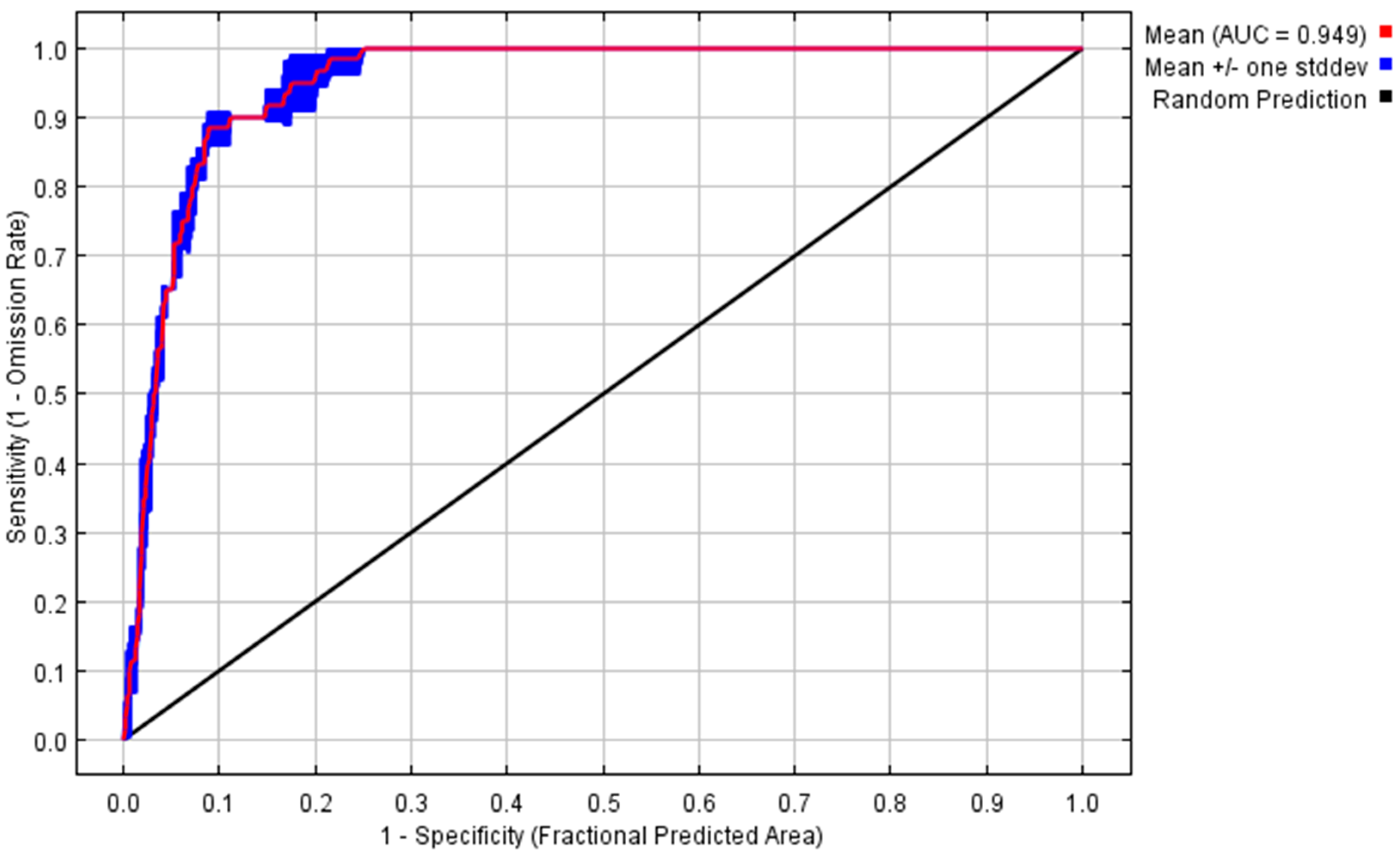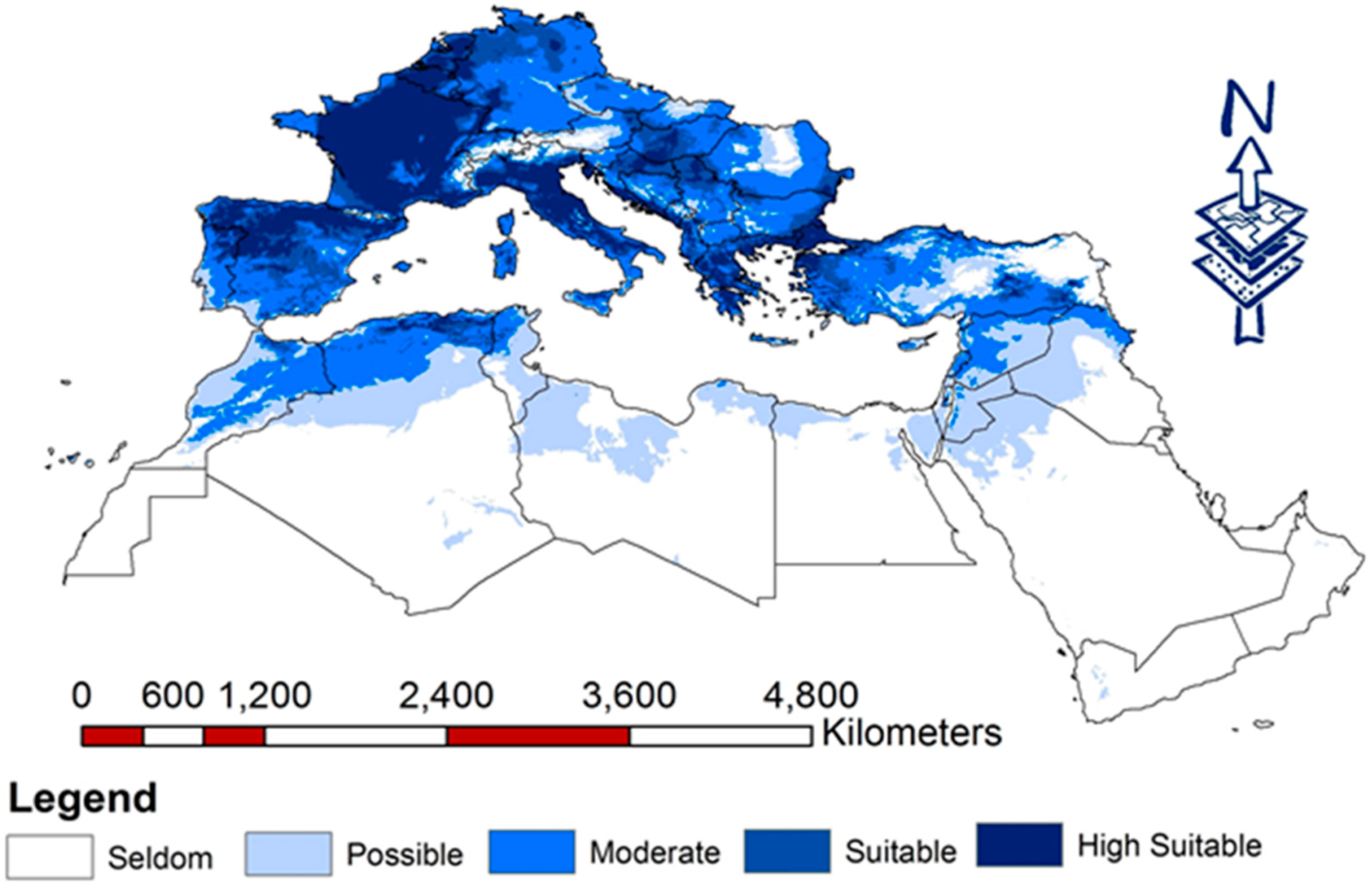Utilizing Ecological Modeling to Follow the Potential Spread of Honey Bee Pest (Megaselia scalaris) from Nearby Countries towards Saudi Arabia under Climate Change Conditions
Abstract
1. Introduction
2. Materials and Methods
2.1. Geographical Range and Records of Megaselia scalaris
2.2. Selection of Environmental Variables
2.3. Modeling Steps and Evaluation
3. Results
3.1. Performance of the Model
3.2. Model Map for Current Conditions
3.3. Model Map for Future Conditions
4. Discussion
5. Conclusions
Funding
Institutional Review Board Statement
Data Availability Statement
Acknowledgments
Conflicts of Interest
References
- Al-Ghamdi, A.; Nuru, A. Beekeeping in the Kingdom of Saudi Arabia opportunities and challenges. Bee World 2013, 90, 54–57. [Google Scholar] [CrossRef]
- Abou-Shaara, H.F.; Al-Ghamdi, A.A.; Mohamed, A.A. A Suitability Map for Keeping Honey Bees under Harsh Environmental Conditions Using Geographical Information System. World Appl. Sci. J. 2013, 22, 1099–1105. [Google Scholar]
- Abou-Shaara, H.F.; Al-Ghamdi, A.A.; Mohamed, A.A. Honey bee colonies performance enhance by newly modified beehives. J. Apic. Sci. 2013, 57, 45–57. [Google Scholar] [CrossRef]
- Al-Ghamdi, A.A.; Alsharhi, M.M.; Abou-Shaara, H.F. Current status of beekeeping in the Arabian countries and urgent needs for its development inferred from a soci-economic analysis. Asian J. Agric. Res 2016, 10, 87–98. [Google Scholar]
- Abou-Shaara, H.F.; Al-Ghamdi, A.A.; Khan, K.A.; Al-Kahtani, S.N. Genetic network analysis between Apis mellifera subspecies based on mtDNA argues the purity of specimens from North Africa, the Levant and Saudi Arabia. Saudi J. Biol. Sci. 2021, 28, 2718–2725. [Google Scholar] [CrossRef]
- Alattal, Y.; Alsharhi, M.; Alghamdi, A.; Alfaify, S.; Migdadi, H.; Ansari, M. Characterization of the native honey bee subspecies in Saudi Arabia using the mtDNA COI–COII intergenic region and morphometric characteristics. Bull. Insectol. 2014, 67, 31–37. [Google Scholar]
- Alabdali, E.A.; Ghramh, H.A.; Ibrahim, E.H.; Ahmad, Z.; Asiri, A.N. Characterization of the native honey bee (Apis mellifera jemenitica) in the south western region of Saudi Arabia using morphometric and genetic (mtDNA COI) characteristics. Saudi J. Biol. Sci. 2021, 28, 2278–2284. [Google Scholar] [CrossRef] [PubMed]
- Al-Qarni, A.S. Tolerance of summer temperature in imported and indigenous honeybee Apis mellifera L. races in central Saudi Arabia. Saudi J. Biol. Sci. 2006, 13, 123–127. [Google Scholar]
- Al-Ghamdi, A.; Adgaba, N.; Getachew, A.; Tadesse, Y. New approach for determination of an optimum honeybee colony’s carrying capacity based on productivity and nectar secretion potential of bee forage species. Saudi J. Biol. Sci. 2016, 23, 92–100. [Google Scholar] [CrossRef]
- Core, A.; Runckel, C.; Ivers, J.; Quock, C.; Siapno, T.; De Nault, S.; Brown, B.; De Risi, J.; Smith, C.D.; Hafernik, J. A new threat to honey bees, the parasitic phorid fly Apocephalus borealis. PLoS ONE 2012, 7, e29639. [Google Scholar] [CrossRef] [PubMed]
- Dutto, M.; Ferrazzi, P. Megaselia rufipes (Diptera: Phoridae): A new cause of facultative parasitoidism in Apis mellifera. J. Apic. Res. 2014, 53, 141–145. [Google Scholar] [CrossRef][Green Version]
- Bordin, F.; Zulian, L.; Granato, A.; Caldon, M.; Colamonico, R.; Toson, M.; Trevisan, L.; Biasion, L.; Mutinelli, F. Presence of Known and Emerging Honey Bee Pathogens in Apiaries of Veneto Region (Northeast of Italy) during Spring 2020 and 2021. Appl. Sci. 2022, 12, 2134. [Google Scholar] [CrossRef]
- Cham, D.T.; Fombong, A.T.; Ndegwa, P.N.; Irungu, L.W.; Nguku, E.; Raina, S.K. Megaselia scalaris (Diptera: Phoridae), an opportunist parasitoid of honey bees in Cameroon. Afr. Entomol. 2018, 26, 254–258. [Google Scholar] [CrossRef]
- Mohammed, S.E.A.R. First report of Apis mellifera carnica Ruttner (Hymenoptera, Apidae) in Saudi Arabia parasitized by a phorid parasitoid (Diptera: Phoridae). J. Apic. Res. 2018, 57, 565–568. [Google Scholar] [CrossRef]
- Abou-Shaara, H.F.; Staron, M. Present and future perspectives of using biological control agents against pests of honey bees. Egypt. J. Biol. Pest Control 2019, 29, 24. [Google Scholar] [CrossRef]
- Jamal, Z.A.; Abou-Shaara, H.F.; Qamer, S.; Alotaibi, M.A.; Khan, K.A.; Khan, M.F.; Bashir, M.A.; Hannan, A.; L-Kahtani, S.N.A.; Taha, E.A.; et al. Future expansion of small hive beetles, Aethina tumida, towards North Africa and South Europe based on temperature factors using maximum entropy algorithm. J. King Saud Univ.–Sci. 2021, 33, 101242. [Google Scholar] [CrossRef]
- Nasser, M.G.; Hosni, E.M.; Kenawy, M.A.; Alharbi, S.A.; Almoallim, H.S.; Rady, M.H.; Merdana, B.A.; Pont, A.C.; Al-Ashaal, S.A. Evolutionary profile of the family Calliphoridae, with notes on the origin of myiasis. Saudi J. Biol. Sci. 2021, 28, 2056–2066. [Google Scholar] [CrossRef] [PubMed]
- Anderson, G.S.; Huitson, N.R. Myiasis in pet animals in British Columbia: The potential of forensic entomology for determining duration of possible neglect. Can. Vet. J. 2004, 45, 993. [Google Scholar] [PubMed]
- Fischer, O.A. An assessment of the sanitary importance of sixteen blowfly species (Diptera: Calliphoridae). Acta Rerum Nat. 2007, 3, 29–36. [Google Scholar]
- Wakid, M.H. A laboratory-based study for first documented case of urinary myiasis caused by larvae of Megaselia scalaris (Diptera: Phoridae) in Saudi Arabia. Korean J. Parasitol. 2008, 46, 33. [Google Scholar] [CrossRef] [PubMed]
- Karunaweera, N.D.; Ihalamulla, R.L.; Kumarasinghe, S.P.W. Megaselia scalaris (Diptera: Phoridae) can live on ripe bananas—A potential health hazard? Ceylon Med. J. 2002, 47, 9–10. [Google Scholar] [CrossRef] [PubMed]
- Abou-Shaara, H.F.; Darwish, A.A.E. Expected prevalence of the facultative parasitoid Megaselia scalaris of honey bees in Africa and the Mediterranean region under climate change conditions. Int. J. Trop. Insect Sci. 2021, 41, 3137–3145. [Google Scholar] [CrossRef]
- Abou-Shaara, H.; Alashaal, S.A.; Hosni, E.M.; Nasser, M.G.; Ansari, M.J.; Alharbi, S.A. Modeling the invasion of the large hive beetle, Oplostomus fuligineus, into north Africa and South Europe under a changing climate. Insects 2021, 12, 275. [Google Scholar] [CrossRef] [PubMed]
- Hosni, E.M.; Nasser, M.G.; Al-Ashaal, S.A.; Rady, M.H.; Kenawy, M.A. Modeling current and future global distribution of Chrysomya bezziana under changing climate. Sci. Rep. 2020, 10, 4947. [Google Scholar] [CrossRef] [PubMed]
- Wei, B.; Wang, R.; Hou, K.; Wang, X.; Wu, W. Predicting the current and future cultivation regions of Carthamus tinctorius L. using MaxEnt model under climate change in China. Glob. Ecol. Conserv. 2018, 16, e00477. [Google Scholar] [CrossRef]
- Polidori, C.; Sánchez-Fernández, D. Environmental niche and global potential distribution of the giant resin bee Megachile sculpturalis, a rapidly spreading invasive pollinator. Glob. Ecol. Conserv. 2020, 24, e01365. [Google Scholar] [CrossRef]
- Abou-Shaara, H.F. Geographical information system for beekeeping development. J. Apic. Sci. 2019, 63, 5–16. [Google Scholar] [CrossRef]
- Le Conte, Y.; Navajas, M. Climate change: Impact on honey bee populations and diseases. Rev. Sci. Tech. 2008, 27, 499–510. [Google Scholar]
- Yoruk, A.; Sahinler, N. Potential effects of global warming on the honey bee. U Bee J. 2013, 13, 79–87. [Google Scholar]
- GBIF. Global Biological Information Facility. 2020. Available online: https://www.gbif.org/occurrence/download/0137620-200613084148143 (accessed on 3 August 2021).
- Eyring, V.; Bony, S.; Meehl, G.A.; Senior, C.A.; Stevens, B.; Stouffer, R.J.; Taylor, K.E. Overview of the coupled model intercomparison project phase 6 (CMIP6) experimental design and organization. Geosci. Model Dev. 2016, 9, 1937–1958. [Google Scholar] [CrossRef]
- Phillips, S.J.; Dudík, M.; Schapire, R.E. Maxent Software for Modeling Species Niches and Distributions (Version 3.4.1). 2020. Available online: http://biodiversityinformatics.amnh.org/open_source/maxent/ (accessed on 20 March 2020).
- Phillips, S.J. A Brief Tutorial on Maxent. 2017. Available online: https://biodiversityinformatics.amnh.org/open_source/maxent/Maxent_tutorial2017.pdf (accessed on 1 August 2021).
- Nasser, M.; El-Hawagry, M.; Okely, M. Environmental niche modeling for some species of the genus Anthrax Scopoli (Diptera: Bombyliidae) in Egypt, with special notes on St. Catherine protected area as a suitable habitat. J. Insect. Conserv. 2019, 23, 831–841. [Google Scholar] [CrossRef]
- Okely, M.; Nasser, M.; Enan, R.; GadAllah, S.; AlAshaal, S. Mantodea oasis of Palaearctic region: Biogeographical analysis of Mantodea in Egypt. Egypt. J. Biol. Pest Control 2020, 30, 136. [Google Scholar] [CrossRef]
- Nasser, M.; Okely, M.; Nasif, O.; Alharbi, S.; GadAllah, S.; Al-Obaid, S.; Enan, R.; Bala, M.; Al-Ashaal, S. Spatio-temporal analysis of Egyptian flower mantis Blepharopsis mendica (order: Mantodea), with notes of its future status under climate change. Saudi J. Biol. Sci. 2021, 28, 2049–2055. [Google Scholar] [CrossRef] [PubMed]
- Disney, R.H.L. Scuttle Flies: The Phoridae; Chapman-Hall: London, UK, 1994; p. 467. [Google Scholar]
- Dama, G. Wonder model organism for forensic entomology and genetic studies—Megaselia scalaris—Its life cycle, breeding methods and wing mutants. Glob. J. Boil. Agric. Health Sci. 2014, 3, 74–79. [Google Scholar]
- Thomas, J.K.; Sanford, M.R.; Longnecker, M.; Tomberlin, J.K. Effects of temperature and tissue type on the development of Megaselia scalaris (Diptera: Phoridae). J. Med. Entomol. 2016, 53, 519–525. [Google Scholar] [CrossRef]
- Ricchiuti, L.; Miranda, M.; Venti, R.; Bosi, F.; Marino, L.; Mutinelli, F. Infestation of Apis mellifera colonies by Megaselia scalaris (Loew, 1866) in Abruzzo and Molise regions, Central-Southern Italy. J. Apic. Res. 2016, 55, 187–192. [Google Scholar] [CrossRef]
- Mulieri, P.R.; Patitucci, L.D. Using ecological niche models to describe the geographical distribution of the myiasis-causing Cochliomyia hominivorax (Diptera: Calliphoridae) in southern South America. Parasitol. Res. 2019, 118, 1077–1086. [Google Scholar] [CrossRef] [PubMed]
- Menail, A.H.; Piot, N.; Meeus, I.; Smagghe, G.; Loucif-Ayad, W. Large pathogen screening reveals first report of Megaselia scalaris (Diptera: Phoridae) parasitizing Apis mellifera intermissa (Hymenoptera: Apidae). J. Invertebr. Pathol. 2016, 137, 33–37. [Google Scholar] [CrossRef]
- Kara, K.; Pape, T. Check list of Turkish Sarcophagidae (Insecta, Diptera) with new records. Dtsch. Entomol. Z. 2002, 49, 291–295. [Google Scholar] [CrossRef]
- Bedini, G.; Pinzauti, M.; Felicioli, A. Interaction between Apis mellifera and its parasites Senotainia tricuspis and Varroa destructor: A teoric model. In Proceedings of the International Apicultural Scientific Conference, Pulawy, Poland, 25–27 April 2006. [Google Scholar]
- Piazza, M.G.; Marinelli, E. Investigation on the presence in Latium of Senotainia tricuspis (Meigen) (Diptera Sarcophagidae), endoparasitoid of Apis mellifera L. Redia 2000, 83, 111–122. [Google Scholar]
- Hosni, E.M.; Nasser, M.; Al-Khalaf, A.A.; Al-Shammery, K.A.; Al-Ashaal, S.; Soliman, D. Invasion of the Land of Samurai: Potential Spread of Old-World Screwworm to Japan under Climate Change. Diversity 2022, 14, 99. [Google Scholar] [CrossRef]






Publisher’s Note: MDPI stays neutral with regard to jurisdictional claims in published maps and institutional affiliations. |
© 2022 by the author. Licensee MDPI, Basel, Switzerland. This article is an open access article distributed under the terms and conditions of the Creative Commons Attribution (CC BY) license (https://creativecommons.org/licenses/by/4.0/).
Share and Cite
Alkhalaf, A.A. Utilizing Ecological Modeling to Follow the Potential Spread of Honey Bee Pest (Megaselia scalaris) from Nearby Countries towards Saudi Arabia under Climate Change Conditions. Diversity 2022, 14, 261. https://doi.org/10.3390/d14040261
Alkhalaf AA. Utilizing Ecological Modeling to Follow the Potential Spread of Honey Bee Pest (Megaselia scalaris) from Nearby Countries towards Saudi Arabia under Climate Change Conditions. Diversity. 2022; 14(4):261. https://doi.org/10.3390/d14040261
Chicago/Turabian StyleAlkhalaf, Areej A. 2022. "Utilizing Ecological Modeling to Follow the Potential Spread of Honey Bee Pest (Megaselia scalaris) from Nearby Countries towards Saudi Arabia under Climate Change Conditions" Diversity 14, no. 4: 261. https://doi.org/10.3390/d14040261
APA StyleAlkhalaf, A. A. (2022). Utilizing Ecological Modeling to Follow the Potential Spread of Honey Bee Pest (Megaselia scalaris) from Nearby Countries towards Saudi Arabia under Climate Change Conditions. Diversity, 14(4), 261. https://doi.org/10.3390/d14040261




